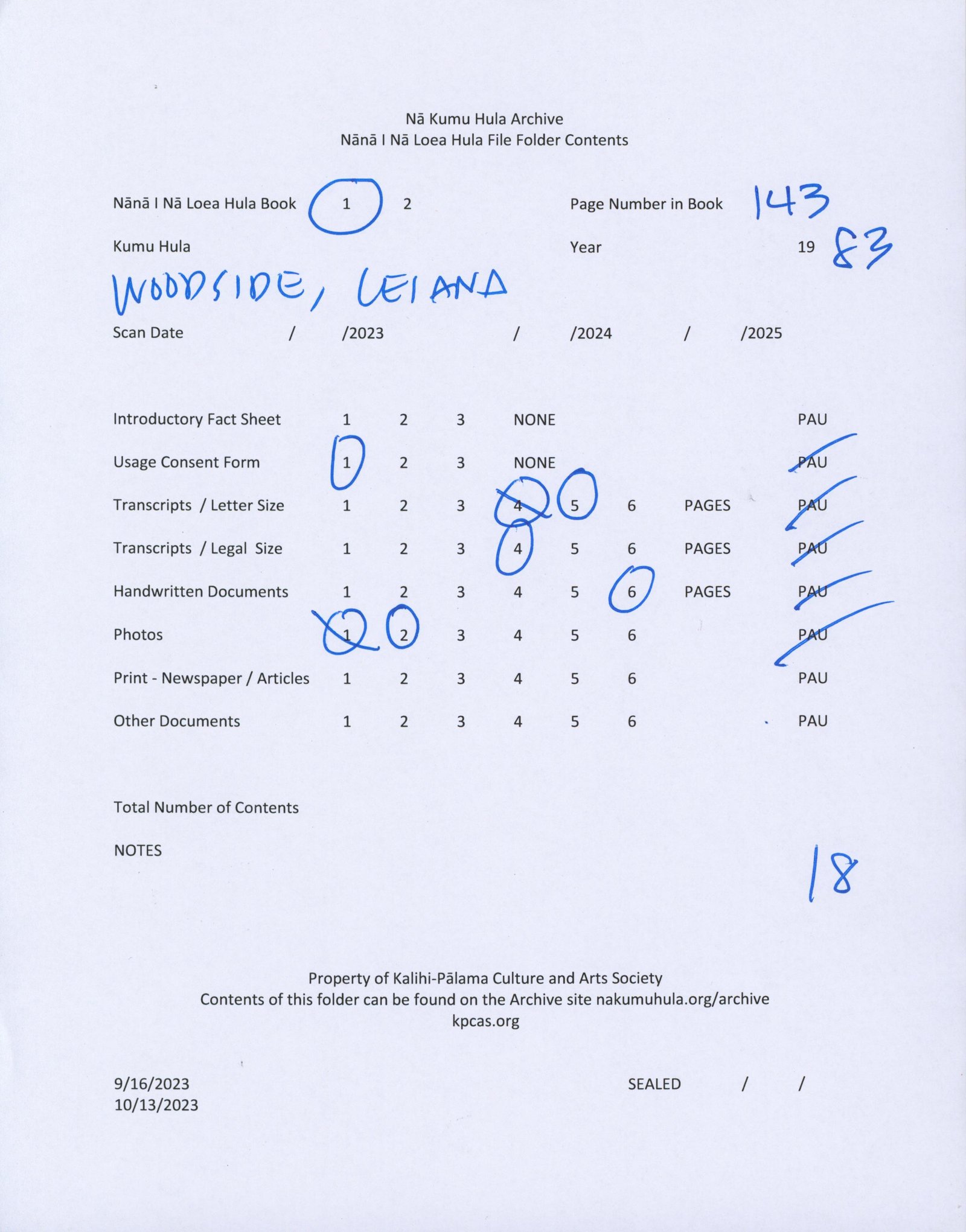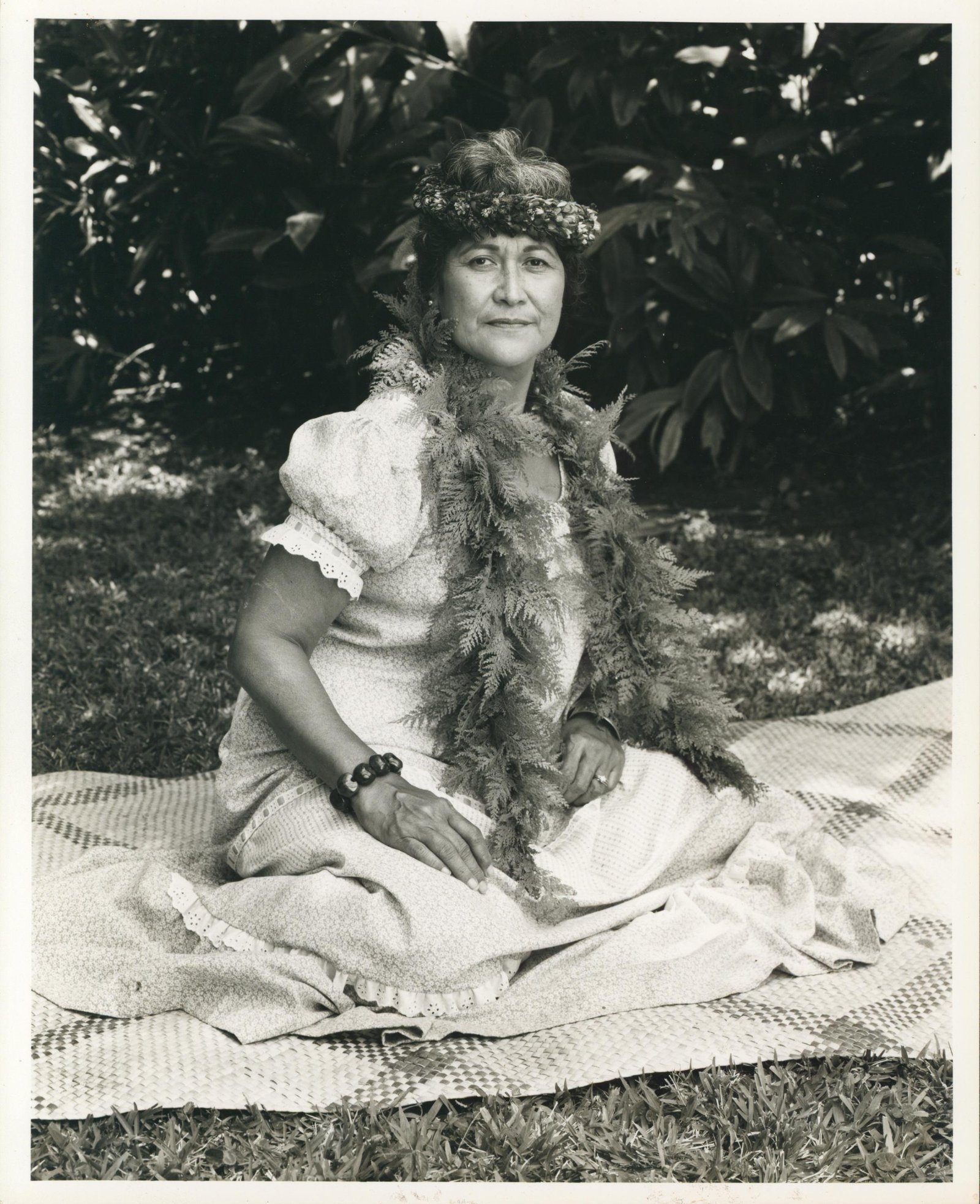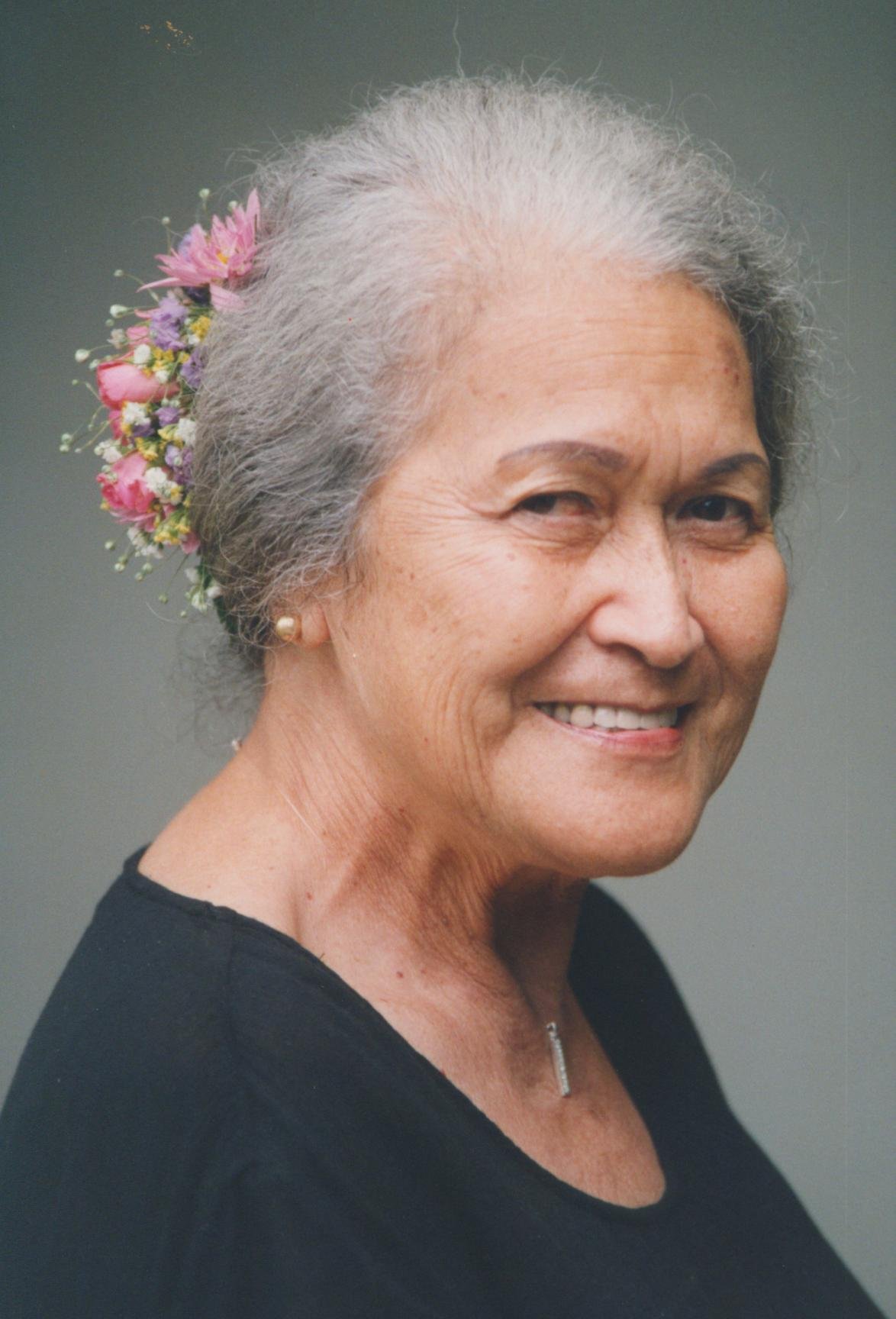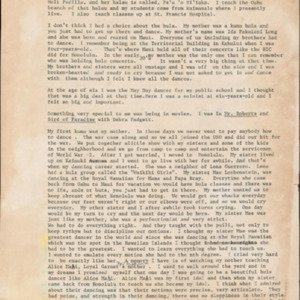Leiana Long Woodside
Title
Leiana Long Woodside
Description
Leiana Long Woodside
Leiana Woodside is the daughter of Ida Pakulani Long of Maui and the sister of Mae Loebenstein and Kāhili Cummings. She is currently affiliated with the Queen Emma Summer Palace in Nuʻuanu, Oʻahu.
I was the seventh of seven girls in my family and was born and reared on Maui in an area called Kauahea; the same area which Kahekili used as his practice ground for combat. Our house was situated just below Kahekili’s heiau Hale Ki‘i. My father Henry Keao Long was originally from Kilauea, Kaua‘i, and my mother was Ida Pakulani Ka‘aihue-Kaianui Long. Mama was a Maui girl and in her early years she was a hula student of Kamawa‘e of Maui. Later she became a kumu hula herself. Therefore, I don’t suppose I had a choice about learning the hula. Everyone in the family, brothers and sisters alike, learned the hula under Mamas tutorage. Mama was a very strict kumu hula but I suppose I have yet to meet someone of my vintage or earlier whose kumu hula was not strict. We had to dance with bended knees, elbows up, head turned toward the extended hand, with eyes looking up beyond the fingertips. If our basic hula exercises were not exactly as she taught them then the pū‘ili was the next boss. It came flying so quickly, I used to swear she had the fastest hands on Maui. As children, my sisters and I would dance the hula on the heiau Hale Ki‘i. Tom Hiona lived down the road from us, and I remember seeing him as a young boy dancing the hula on the same heiau.
I remember asking my mother about her hula training. I had not yet heard of the book The Unwritten Literature of Hawaiʻi on Maui and she unfolded a story which seemed to me at that time to be embarrassing, strange, and exotic. She mentioned the ‘ailolo ceremony and while I did not see the ritual, I did see her on several occasions, picking at the po‘opua‘a and eating the lolo. She also mentioned the cleansing rituals of bathing in the sea at midnight and returning to the hālau which was an open lanai with coconut leaves for a roof. In the middle of that lānai was a fire pit around which the hula students slept on lau hala mats with their feet towards the fire. She said they were taught that the strength of the hula was in the footwork, and if the feet were strong the rest of the dancer was strong.
She told me, ‘Today, you go to a hula hālau and learn the basic steps and hula choreography all together with your kumu hula but in my days we dreamt our hula. When I fell asleep I heard drumming and chanting and in my dreams I’d see myself dancing a whole, new hula, over and over again, all through the night until the crow of the rooster at dawn. I awoke and remembered everything that was shown to me in the dream. The next day at hula class the kumu would pa‘i his ipu, the po‘opua‘a would kāhea and we all danced in unison the same hula that I had dreamt of the night before. If a student appeared unsure of the dance, the kumu knew that the student had gone ‘auana the night before, and that student had to go through a whole cleansing ritual again or was asked to leave the hālau.’
She also said that in her time the prime age for hula dancing was considered between three and twelve-years-old. The children within this age group were reserved for the ancient kapu-kapu or sacred temple dances because they were believed to be clean and pure and therefore dedicated to the gods. The dances of the children beyond this age group were more ‘auana and so their movements were allowed to be more descriptive.
For many years I kept these accounts of my mother’s past hidden with mixed feelings. In 19511 went to the Library of Hawai‘i and asked if they had any books on traditional Hawaiian chants and dances, and the librarian handed me The Unwritten Literature of Hawaiʻi. Imagine my surprise when feasting my eyes on this recorded aspect of Hawaii’s history. My whole inside just surged with understanding, pride, and love for my mother.
Another memory I have is watching Mama’s hula classes and I was especially fascinated with one of her students. The student’s name was Alice Mahi and she would later become Alice Keawekāne Garner. At the age of five I would walk around the yard and in my dreams I promised myself that one day I was going to be a beautiful hula dancer just like Alice Mahi. But as I grew older my idol became my sister Mae Loebenstein who at that time was dancing at the Royal Hawaiian Hotel with Mama and Daddy Bray. Several times a year she would return to Maui and my mother wanted us to keep abreast of what was happening with the hula in Honolulu; so Mae would hold hula classes everyday during her visit. Back then the Royal Hawaiian Hotel was “the” spot in the Hawaiian Islands where the elite from all over the world met, and because Mae danced there I wanted to learn everything she had to teach us. I tried to emulate every motion she taught to the nth degree.
In 1945 I married and moved to Honolulu to live with my sister Mae in Kaimuki. She was a neighbor of Lena Guerrero and it was through Lena that I began to perform. Lena asked me to train with her and when I turned twenty-one I began dancing with her hula group The Waikiki Girls at the Royal. In those days you had to dance in many locations in one night. You might start at the cocktail hour at the Moana Hotel, go to a nine o’clock floor show at the Royal Hawaiian, then go to the eleven o’clock show at Don the Beachcomber’s. In the end we had to change in the car as we drove to each place. When you arrived at the hotel you just grabbed your things and ran from the car onto the stage just in time to the accompaniment of the musical fanfare. Back in the Forties and Fifties the hālaus were called hula troupes and the kumus thought nothing of sharing their haumāna. As a result it was easy for me to study informally under people like Alice Mahi, ‘Iolani Luahine, Joseph Kahaulilio, and Sally Wood Nālua‘i. There were times when we even helped our kumu hula choreograph some of our hula.
In 1947 I started my first hula class teaching a group of Punahou School teachers. One of them lived in an apartment across the campus and we met there for classes. I encourage my haumana to create what they feel. Some of the old kumu feel their way is the only way of dancing. They say that traditional motions and dances have been handed down from generation to generation without changes. I don’t believe that’s the way it was done because it doesn’t explain the great variety we have in our chants and dances. If everything had been passed down without change our dance would be so monotonous. Our ancestors must have created on their own or we wouldn’t have such beauty in the culture.
Today the hula is being learned by people of all races, some with more interest than the Hawaiians themselves, and the wonderful thing about it is that the hula has helped these other races understand the Hawaiian a little more socially and culturally. We have lost a lot but we still have a lot left. If the kupuna were here today surely they would be writing chants and perhaps choreographing dances about things that inspire them in today’s world. May this same inspiration and tradition be allowed to continue in our young people of today.
Leiana Woodside is the daughter of Ida Pakulani Long of Maui and the sister of Mae Loebenstein and Kāhili Cummings. She is currently affiliated with the Queen Emma Summer Palace in Nuʻuanu, Oʻahu.
I was the seventh of seven girls in my family and was born and reared on Maui in an area called Kauahea; the same area which Kahekili used as his practice ground for combat. Our house was situated just below Kahekili’s heiau Hale Ki‘i. My father Henry Keao Long was originally from Kilauea, Kaua‘i, and my mother was Ida Pakulani Ka‘aihue-Kaianui Long. Mama was a Maui girl and in her early years she was a hula student of Kamawa‘e of Maui. Later she became a kumu hula herself. Therefore, I don’t suppose I had a choice about learning the hula. Everyone in the family, brothers and sisters alike, learned the hula under Mamas tutorage. Mama was a very strict kumu hula but I suppose I have yet to meet someone of my vintage or earlier whose kumu hula was not strict. We had to dance with bended knees, elbows up, head turned toward the extended hand, with eyes looking up beyond the fingertips. If our basic hula exercises were not exactly as she taught them then the pū‘ili was the next boss. It came flying so quickly, I used to swear she had the fastest hands on Maui. As children, my sisters and I would dance the hula on the heiau Hale Ki‘i. Tom Hiona lived down the road from us, and I remember seeing him as a young boy dancing the hula on the same heiau.
I remember asking my mother about her hula training. I had not yet heard of the book The Unwritten Literature of Hawaiʻi on Maui and she unfolded a story which seemed to me at that time to be embarrassing, strange, and exotic. She mentioned the ‘ailolo ceremony and while I did not see the ritual, I did see her on several occasions, picking at the po‘opua‘a and eating the lolo. She also mentioned the cleansing rituals of bathing in the sea at midnight and returning to the hālau which was an open lanai with coconut leaves for a roof. In the middle of that lānai was a fire pit around which the hula students slept on lau hala mats with their feet towards the fire. She said they were taught that the strength of the hula was in the footwork, and if the feet were strong the rest of the dancer was strong.
She told me, ‘Today, you go to a hula hālau and learn the basic steps and hula choreography all together with your kumu hula but in my days we dreamt our hula. When I fell asleep I heard drumming and chanting and in my dreams I’d see myself dancing a whole, new hula, over and over again, all through the night until the crow of the rooster at dawn. I awoke and remembered everything that was shown to me in the dream. The next day at hula class the kumu would pa‘i his ipu, the po‘opua‘a would kāhea and we all danced in unison the same hula that I had dreamt of the night before. If a student appeared unsure of the dance, the kumu knew that the student had gone ‘auana the night before, and that student had to go through a whole cleansing ritual again or was asked to leave the hālau.’
She also said that in her time the prime age for hula dancing was considered between three and twelve-years-old. The children within this age group were reserved for the ancient kapu-kapu or sacred temple dances because they were believed to be clean and pure and therefore dedicated to the gods. The dances of the children beyond this age group were more ‘auana and so their movements were allowed to be more descriptive.
For many years I kept these accounts of my mother’s past hidden with mixed feelings. In 19511 went to the Library of Hawai‘i and asked if they had any books on traditional Hawaiian chants and dances, and the librarian handed me The Unwritten Literature of Hawaiʻi. Imagine my surprise when feasting my eyes on this recorded aspect of Hawaii’s history. My whole inside just surged with understanding, pride, and love for my mother.
Another memory I have is watching Mama’s hula classes and I was especially fascinated with one of her students. The student’s name was Alice Mahi and she would later become Alice Keawekāne Garner. At the age of five I would walk around the yard and in my dreams I promised myself that one day I was going to be a beautiful hula dancer just like Alice Mahi. But as I grew older my idol became my sister Mae Loebenstein who at that time was dancing at the Royal Hawaiian Hotel with Mama and Daddy Bray. Several times a year she would return to Maui and my mother wanted us to keep abreast of what was happening with the hula in Honolulu; so Mae would hold hula classes everyday during her visit. Back then the Royal Hawaiian Hotel was “the” spot in the Hawaiian Islands where the elite from all over the world met, and because Mae danced there I wanted to learn everything she had to teach us. I tried to emulate every motion she taught to the nth degree.
In 1945 I married and moved to Honolulu to live with my sister Mae in Kaimuki. She was a neighbor of Lena Guerrero and it was through Lena that I began to perform. Lena asked me to train with her and when I turned twenty-one I began dancing with her hula group The Waikiki Girls at the Royal. In those days you had to dance in many locations in one night. You might start at the cocktail hour at the Moana Hotel, go to a nine o’clock floor show at the Royal Hawaiian, then go to the eleven o’clock show at Don the Beachcomber’s. In the end we had to change in the car as we drove to each place. When you arrived at the hotel you just grabbed your things and ran from the car onto the stage just in time to the accompaniment of the musical fanfare. Back in the Forties and Fifties the hālaus were called hula troupes and the kumus thought nothing of sharing their haumāna. As a result it was easy for me to study informally under people like Alice Mahi, ‘Iolani Luahine, Joseph Kahaulilio, and Sally Wood Nālua‘i. There were times when we even helped our kumu hula choreograph some of our hula.
In 1947 I started my first hula class teaching a group of Punahou School teachers. One of them lived in an apartment across the campus and we met there for classes. I encourage my haumana to create what they feel. Some of the old kumu feel their way is the only way of dancing. They say that traditional motions and dances have been handed down from generation to generation without changes. I don’t believe that’s the way it was done because it doesn’t explain the great variety we have in our chants and dances. If everything had been passed down without change our dance would be so monotonous. Our ancestors must have created on their own or we wouldn’t have such beauty in the culture.
Today the hula is being learned by people of all races, some with more interest than the Hawaiians themselves, and the wonderful thing about it is that the hula has helped these other races understand the Hawaiian a little more socially and culturally. We have lost a lot but we still have a lot left. If the kupuna were here today surely they would be writing chants and perhaps choreographing dances about things that inspire them in today’s world. May this same inspiration and tradition be allowed to continue in our young people of today.
Citation
“Leiana Long Woodside,” Nā Kumu Hula Archive, accessed December 13, 2025, https://nakumuhula.org/archive/items/show/89.






